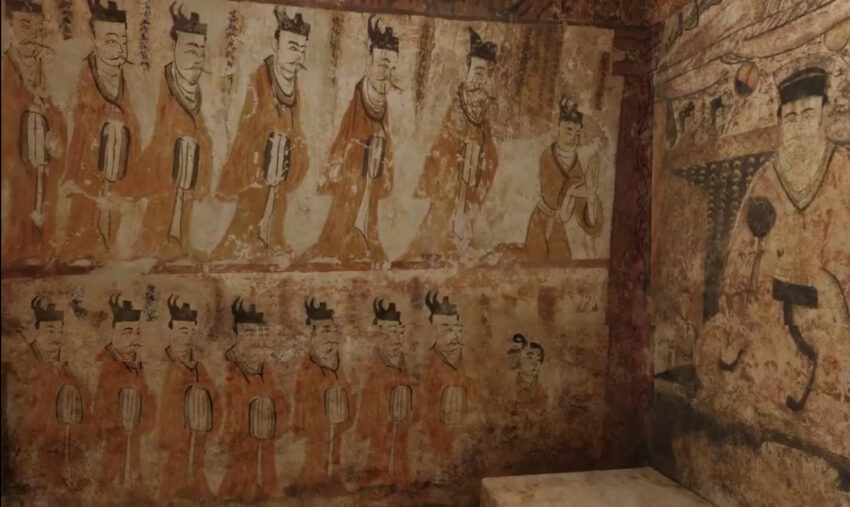The Complex of Koguryo Tombs, located in the Democratic People’s Republic of Korea, is a significant cultural heritage site from the Koguryo Kingdom, which thrived from 37 BC to 668 AD. This collection of tombs, many of which have elaborate wall paintings, offers a unique glimpse into the life, culture, and beliefs of this ancient kingdom. The tombs, mostly built for royalty and nobility, are remarkable for their scale, number, and the richness of their contents, including the murals that depict both mundane and fantastical scenes.
Get your dose of History via Email
Historical Background of the Complex of Koguryo Tombs
The Complex of Koguryo Tombs was built by the Koguryo Kingdom, one of the Three Kingdoms of Korea. This kingdom was known for its military prowess and cultural achievements. The tombs were constructed to honor and house the remains of the kingdom’s elite. They were discovered in the 20th century, revealing a wealth of historical and cultural information.
Archaeologists have been studying the tombs since their discovery, piecing together the history of the Koguryo people. The tombs’ construction dates back to the peak of the Koguryo Kingdom’s power. They reflect the complex social structure and the cultural influences from neighboring regions.
The Koguryo Kingdom had interactions with various Chinese dynasties and the cultures of Central Asia, which influenced the art and architecture of the tombs. The builders of these tombs were skilled artisans who created a lasting legacy. The tombs have survived centuries, though some have suffered from natural and human-induced damage.
The site has not only served as a burial ground but also as a historical record. The murals inside the tombs provide insights into the daily life, customs, and beliefs of the Koguryo people. The tombs have not been continuously inhabited but have been revered and protected throughout history.
The Complex of Koguryo Tombs has gained international recognition for its historical importance. It was inscribed on the UNESCO World Heritage List in 2004, ensuring that efforts will continue to preserve and study this window into ancient Korea.
About the Complex of Koguryo Tombs
The Complex of Koguryo Tombs is an ensemble of ancient burial sites. These tombs, often referred to as ‘pyramid-shaped’ due to their stone mounds, are scattered across the regions of Pyongyang and Nampo. They are constructed from stone and earth, with some featuring elaborate corridors and chambers.
The most striking feature of these tombs is the detailed wall paintings. These murals depict a variety of scenes, from royal processions to mythical creatures. The artistry demonstrates a high level of skill and provides a colorful portrayal of Koguryo society.
The construction methods of the tombs were advanced for their time. Builders used stones and bricks with remarkable precision. The architectural highlights include stone arches and domed ceilings, which have withstood the test of time.
The materials used in the tombs’ construction varied, but most commonly included local stone, lime, and earthen materials. The builders employed techniques that ensured the tombs’ durability, which is why many remain in good condition today.
The tombs’ design and construction reflect the Koguryo Kingdom’s wealth and the high status of those entombed within. The care taken in their creation underscores the reverence the Koguryo people had for their deceased leaders and nobles.
Theories and Interpretations
The Complex of Koguryo Tombs has been the subject of various theories and interpretations. The purpose of the murals, for instance, is believed to be more than decorative. Some scholars suggest they served a spiritual or religious function, guiding the deceased in the afterlife.
The exact meanings of some symbols and scenes in the murals remain a mystery. Researchers continue to compare them with historical records to gain a better understanding. The tombs’ alignment and location have also been analyzed, suggesting an awareness of astrological or geomantic principles.
Dating the tombs has been a meticulous process. Experts have used a combination of historical records, architectural styles, and scientific methods like radiocarbon dating. These efforts have helped establish a clearer timeline for the construction of the tombs.
Interpretations of the tombs’ significance have evolved over time. Initially, they were seen primarily as historical artifacts. Now, they are recognized as masterpieces of human creativity and as symbols of the Koguryo Kingdom’s strength and sophistication.
The ongoing study of the Complex of Koguryo Tombs continues to reveal new insights. Each discovery adds to our understanding of this ancient civilization and its lasting impact on the region’s history.
At a glance
Country: Democratic People’s Republic of Korea
Civilization: Koguryo Kingdom
Age: 37 BC to 668 AD

